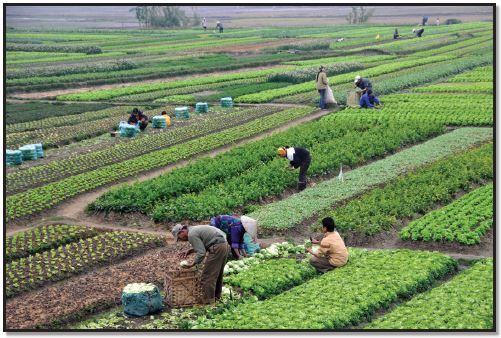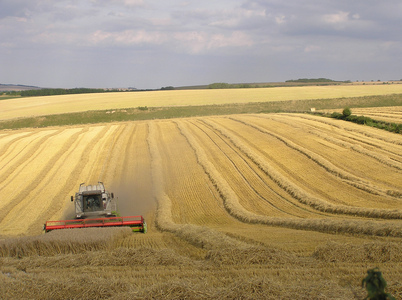A Comprehensive Overview to Commercial Farming vs Subsistence Farming Practices
A Comprehensive Overview to Commercial Farming vs Subsistence Farming Practices
Blog Article
Checking Out the Technological Developments Changing Precision Farming Today
As the agricultural field grapples with the challenges of feeding a growing populace and guaranteeing sustainability, technological technologies are reshaping the landscape of accuracy farming. The complete effect of these developments on conventional farming techniques and their long-term sustainability continues to be a subject ripe for exploration.
Drones in Farming

Drones help with exact monitoring of huge farming areas, determining locations needing interest, such as insect problems or nutrition shortages. This targeted approach enables for the maximized application of plant foods, pesticides, and water, decreasing waste and ecological influence. Drones significantly decrease the time and labor typically needed for field evaluations, enhancing performance and lowering operational prices.
Beyond information collection, drones contribute in precision growing and plant splashing, making certain uniform distribution and reducing ground disruption. The assimilation of drones right into agriculture exemplifies a shift in the direction of data-driven farming techniques, where innovation not only increases conventional techniques however additionally introduces cutting-edge solutions for future challenges. As the agricultural field faces stress from climate modification and population development, drones offer an appealing method for lasting rise and source conservation.
Satellite Images Advances
While drones have actually substantially enhanced accuracy farming with aerial information collection, satellite images proceeds to play a crucial role in broadening the range and range of agricultural tracking. Satellite innovation supplies huge insurance coverage, allowing farmers to accessibility critical understandings over comprehensive locations, which is not possible with drone technology alone. This is especially valuable for large farms that require comprehensive, regular information.
Developments in satellite images have actually caused considerable improvements in resolution and regularity of information capture. Modern satellites can now give imagery with resolutions as great as 30 centimeters per pixel, enabling in-depth evaluation of plant health and wellness, dirt conditions, and watering patterns. Additionally, the frequency of satellite passes has actually enhanced, making sure that farmers can receive updated details regularly. This timely information is essential for making notified, real-time decisions to enhance crop returns and source usage.
Moreover, the integration of hyperspectral and multispectral imagery has actually enhanced the data quality, allowing the accurate recognition of plant varieties, growth stages, and stress factors. With artificial intelligence algorithms, farmers can interpret satellite data better, projecting plant efficiency and prospective issues with extraordinary precision. These innovations are critical in boosting sustainable farming methods internationally.
IoT in Farming
The development of the Internet of Points (IoT) in farming stands for a paradigm change in agricultural management methods, offering unparalleled connection and data-driven understandings. As IoT gadgets multiply across farmland, they offer real-time monitoring and control over different farming procedures. These clever gadgets, that include dirt sensing units, climate stations, and animals tracking systems, collect and transmit data to central systems, making it possible for farmers to optimize and make educated decisions source use.
IoT technology assists in accuracy farming by boosting the accuracy of data collected from the area. For example, soil moisture sensing units can identify variations in moisture degrees, permitting exact watering organizing, which saves water and advertises healthier plant development. Environment sensors provide important information on temperature and humidity, assisting in insect and condition management with prompt interventions.
Moreover, IoT-enabled machinery, such as autonomous tractors and drones, even more streamline procedures by automating labor-intensive tasks and minimizing human mistake. These advancements not only enhance performance but likewise add to sustainability by reducing inputs like water, plant foods, and pesticides. As IoT continues to advance, its integration right into farming techniques will likely grow, driving efficiency and sustainability in the agricultural market.
AI-Driven Analytics
Structure upon the durable information collection abilities of IoT, expert system (AI) arises as a powerful tool in changing raw information right into workable insights for accuracy farming. AI-driven analytics leverages artificial intelligence algorithms to examine large datasets accumulated from drones, sensing units, and satellites. This makes it possible for farmers to make enlightened decisions pertaining to plant monitoring, dirt health and wellness, and source allowance. By recognizing patterns and forecasting end results, AI empowers farmers to enhance their methods, bring about boosted return and lowered waste.

Moreover, AI-driven analytics sustain precision farming by offering customized recommendations for growing schedules and watering management. These insights help optimize water usage, straightening with sustainability goals. By delivering real-time understandings and Extra resources tactical advice, AI-driven analytics not just enhance functional effectiveness yet also add in the direction of sustainable farming techniques, safeguarding food supply chains for the future.
Robotics and Automation
In the realm of precision farming, robotics and automation are reinventing agricultural practices by providing unmatched effectiveness and accuracy - commercial farming vs subsistence farming. These innovations are increasingly being incorporated right into various farming news processes, from planting and gathering to surveillance and maintenance. Automated systems, such as robotic farmers and autonomous tractors, enable the optimization of labor-intensive jobs, decreasing human error and labor expenses. These machines are geared up with sensing units and general practitioners technology, allowing them to run with high accuracy and adjust to differing area conditions.
Furthermore, robot systems improve plant surveillance and monitoring. Drones outfitted with imaging modern technology can check big locations promptly, supplying real-time information on crop wellness and dirt problems. This details is important for making notified choices regarding fertilizing, watering, and parasite control, thus boosting return and resource performance. In addition, robot weeders and planters boost the accuracy of these tasks, causing much more effective usage of inputs.
The integration of robotics and automation in accuracy farming also resolves sustainability concerns (commercial farming vs subsistence farming). By optimizing inputs and making best use of outcomes, these innovations aid minimize ecological effect. Subsequently, robotics and automation not just change agricultural performance however additionally add significantly to sustainable farming techniques.
Conclusion
Technical developments are basically improving accuracy farming by incorporating sophisticated devices like drones, satellite images, IoT tools, AI-driven analytics, and robotics. Robotics even more streamline operations, leading to cost reductions and find here improved efficiency, ultimately changing traditional farming techniques.
Reinventing the farming landscape, drones have actually emerged as a critical tool in accuracy farming.IoT modern technology assists in precision farming by boosting the accuracy of information gathered from the field.Building upon the robust information collection capabilities of IoT, fabricated knowledge (AI) emerges as a powerful tool in transforming raw data into workable insights for accuracy farming.In the realm of accuracy farming, robotics and automation are reinventing agricultural techniques by providing extraordinary effectiveness and accuracy.Technological advancements are essentially improving precision farming by incorporating sophisticated devices like drones, satellite images, IoT tools, AI-driven analytics, and robotics.
Report this page